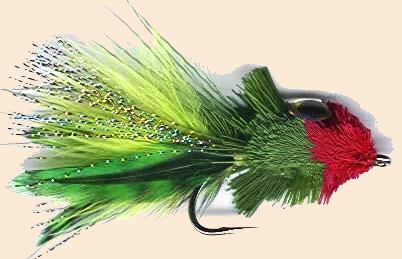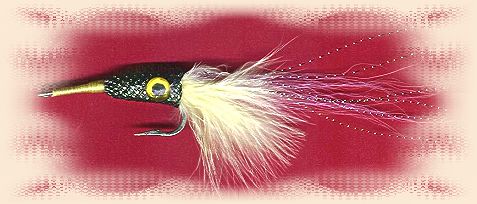This is the time of year for fly tying. Once the cold weather comes the fishing
gets slow. How cold could it get in Florida? A 38-degree morning is
not uncommon. It is often windy and continues to blow into the afternoon.
The wind chill on the water can make fishing uncomfortable. So it's a good time
to "chill-out" and tie some flies.
Fly tying is a labor of love: most of the time. This is necessary part of a guide's life.
What a great time to listen to favorite music. This is just enough distraction to keep
me focused on tying Borski's, Clousers, Deceivers, Redbones, Divers, Hair bugs,
and countless other patterns that I keep in my arsenal.
I'll tie more than a thousand flies over the winter. Some I sell to local tackle shops,
but most will be used in charters. Just think of all those fish that find these patterns
so irresistible. Imagine creating baitfish in the privacy of your home or workshop.
My wife can never understand the buckets and buckets of tying materials found in
my workshop. I've had some for 10 years or more. Hey! You never know when
you might need something. I'll be sure to leave them to JC in my Will.
There are saddle hackles, bucktail, spinning hair, flash, etc., etc. Every tying material
known to mankind at my finger tips. There are some really expensive tying materials too.
I happen to like top quality spinning hair that I've only found through Chris Helm at
Whitetail Fly Tieing Supplies in Toledo, Ohio. These are the finest spinning hairs I've
ever used. I'm not alone in this assessment. Bob Popovics, Ken Bay and Lefty Kreh
are among the professionals that order pounds and pounds of this stuff. I'm in good
company. Another vice is my passion for black-laced orange and yellow hen capes.
Man that's expensive. Whiting American makes outstanding hackles. Sitting for
hours in my chair hunched over my vise and worktable can be a back-breaker. But
it is a comfort to know that my charters appreciate the artistry and craft and attention
to detail that goes into tying these masterpieces. My clients always get their choice of
two flies used on our trips. The greatest thrill is when I receive a letter or phone call
from an angler or another guide who has used that "secret" fly and how well it performed.
Not long ago I sent three flies to a guide friend in Satellite Beach. He wrote me a note.
"I wanted to say thanks again for the flies you gave me. I had to make Stan
give them up long enough to catch 8 snook to 12 lbs. along with some dinkish
trout and a bluefish last Saturday morning on a charter! The finger mullet was the
ticket. It was the morning after our first real rain, which caused the creeks to flow
and flush out baitfish that would not normally be on the move. This is one of my
favorite times of the year in my beloved snook spots. Needless to say my charter
from California was stoked with his catch. Thought you might like to know that
the finger mullet fly is on his last leg!!! Poor thing". JB Cook
Needless to say, I sent JB more mullet flies. Just in case anyone is reading this from Maine,
the mullet flies work well on Stripers. Warren and I caught 53 stripers in two days.
"The 12-pounder [Snook] hit the RedHead on my first cast!" an excited angler called to
tell me. Fishing in a backwater creek requires different tactics than fishing an open grass
flat. Matching the situation means understanding flies that work well in a given location.
If you fish every day and learn fish movement and habits, then matching flies to the situation
is relatively easy. If you don't have this luxury then ask local fisherman what bait they are
using, or ask what the fish are eating, how far down their hitting, conditions of the water, etc.
There are many factors that enter into a decision about which fly to use where. I'm
often asked which is my favorite fly.
This is a tough question. I have two favorite flies. A Dixie Chick and the RedHead.
The Redhead is a variation of the Tomoka Mullet (Ken Bay) and a Sand Perch (Phil
Chapman). Will they work everywhere? No. Can you buy them anywhere? No.
I know of only one other person who ties the Tomoka Mullet (Ken Bay, he taught me).
This is a great fly. Capt John Ford, Portland Guide Service loves this fly for Stripers
in Maine. This is not an easy fly to tie. The collar is similar to Ty's Tantilizer (Tim
England's fly). The proportions are similar to Ty's and the action is so amazing. I pack
and stack the fly tightly using different dyed deer spinning hairs. My favorite combinations
are green/red-head, yellow/red-head, tan/tan-head. It is tied similar to the standard
Tomoka Mullet but denser. The action in the water is superb. This fly works best in
the dark water of backcountry rivers or creeks. The green/red-head version is
outstanding in the winter months when the lagoon is clear. I tie flat-rubber skirt
material to the tail. Trout cannot resist this fly and will come out of deep grass to
engulf it.

The Dixie Chick is a great fly for open fast moving water around piers, bridges and inlet
jetties. This fly uses marabou and fox tail. A fast stripping action will entice strikes
from Tarpon, Snook, Trout, Jacks, and Barracuda. Barracuda love this fly, and they
aren't supposed to. One of the reasons I like this fly is I like the way it looks. And it
is a simple fly to tie. The marabou and foxtail is tied in at the hook bend. Some flash
is added. Then E-Z Body forms the body and collar. Finally, I tie off the nose to the
hook eye add prismatic eyes and epoxy the head. You can tie this fly in about 10 minutes.
In fast moving water it rides upright and makes a nice side-to-side wiggling action.
Strikes on this fly come fast like lightning bolts.

I have many favorites including my Redfish Diver (Redington's
Fly of the Month), Foxy Clouser, Hot Lips, and others. Our Indian River Estuary
System is so diverse there are many flies that work. Just imitate the bait and you'll
catch fish. I asked a guide friend of mine what his favorite fly was. He said, "The
one that catches fish is my favorite."
I'll let you in on a little secret. Presentation and retrieval techniques have more to do
with catching fish than the size and shape of a fly, or lure. However, color and sound
matter more, and the action of the fly in the water, especially true for sinking or top
water flies. Just remember to think about what the fish are eating. Is the bait a fast
swimmer, does it dart, hop or bury itself? If chased, does it swim in the upper
water-column? Answers to these questions will catch you more fish.
~ Doug.
About Doug:
Doug is a USCG Licensed Captain and fly-fishing guide from New Smyrna Beach, FL
a member of CCA, FFF, AFF, APCA, FOWA, the Action Craft Saltwater Team,
and the Orvis and Redington Pro-Guide Program. He can be reached at 386-679-5814.
|







